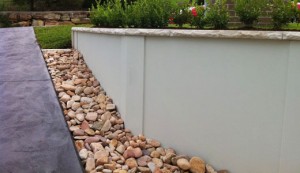In my hilly area, retaining walls are a necessity. They are used for both structural and decorative reasons. They serve the structural need of a garden to support paths, maintain slopes, create levels and for drainage purposes.
When the structural retaining wall material is carefully chosen to suit the overall theme of the garden and house and its contours direct the eyes and create interest, it becomes a decorative one as well. A well designed and constructed retaining wall can be used to create the atmosphere of a garden.
The range of materials and look nowadays is so vast and of such good quality that what could have once been the ugly duckling can now be proudly shown.
The main cause of retaining wall failure is hydrostatic pressure behind the wall. Careful planning of the drainage will prevent this from happening.
One word of caution though, careful choice of plants behind and around the retaining wall is of the utmost importance. Failure to do so could see you having a retaining wall that fails within a few years.
I have seen good workmanship in construction and engineering be wasted by a poor choice of vegetation. More often than not it is due to trees planted too close to the retaining wall or invasive root system clogging the drainage.
Do use a qualified horticulturist to help you choose the plants with the right root system for the wall, soil, and space. If you are not involved with the planting design yourself, a horticulturist can provide you with a list of recommended plants, suited to the particulars of the site, which you can then give to your clients.
Photo courtesy of Modular Wall Systems.
|
|
About Patrick Regnault
I have worked in the horticultural and landscaping industry for over 35 years in three different countries.I am a member and Registered Horticulturist with the Australian Institute of Horticulture and member of the Housing Industry Association. I am the owner of Interactive Landscapes, a successful structural landscaping and landscape design business. I believe that what gardens and gardening do is to reconnect people with the fundamental elements of nature. A good gardener will try and acquire a profound understanding of the balance of nature and endeavour to do the best to improve the environment in which the garden is situated. At Interactive Landscapes it is a philosophy that we put into practice when designing and creating a garden, no matter the size. Our name reflects this as we understand that gardens are a place of interaction. View all posts by this author » |










